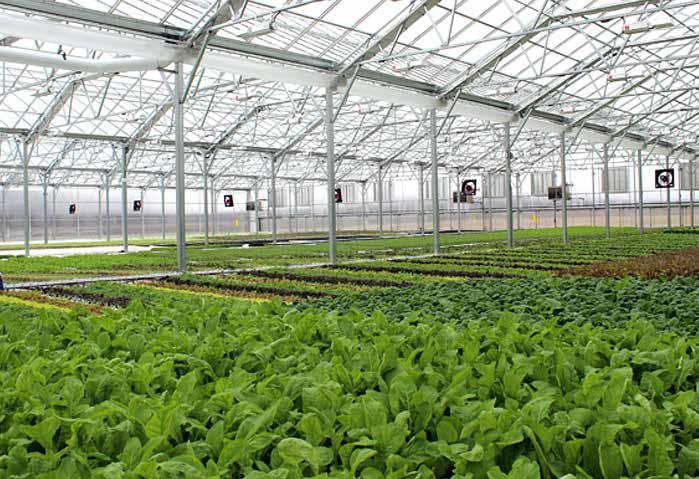
3 minute read
Si may reduce the need for synthetic fungicides
greeNhOUSeS I Shade Net I hYdrOpONIcS I aqUapONIcS
Si may reduce the need for synthetic fungicides
Advertisement
Si is readily available in the soil, being the second most abundant element, after oxygen, present in the earth’s crust as silicon dioxide (sand) and various silicates or sheet silicates. Silicon is extracted from sheet silicates as silicic acid. Silicate minerals weather to clay, which forms the soils in which plants grow.
Soil water generally contains 50 to 400 ppm silicic acid, which is readily absorbed by plants. Hydroponic nutrient solutions should contain potassium silicate or treated with10 parts per million of silicic acid (H²SiO³), although hydroponically grown cucumbers are often grown in nutrient solutions without added Si. Studies of plant tissue have found a range of silicon content from a fraction of 1% dry matter to as high as 10%. In plants, the silicon seems to play a role in growth, mineral nutrition, mechanical strength, resistance to fungal diseases, and reaction to adverse chemical conditions.
Role of Silicon
Studies regarding silicate applied as a fungicide at the Pacific Agri-food Research Centre (PARC) in British Columbia first explored powdery mildew (PM) control and increased yield by adding silicate to growing media, with good control of powdery mildew on grapes, melons, zucchini, and cucumber. Continuing studies reveal that the form of silicon in solution and the solution pH greatly affect the efficacy. Fungal disease resistance in greenhouse cucumbers was shown to increase substantially in response to Si fertilization. Different rates of Si fertilization (potassium silicate) on powdery mildew was tested on cucumber leaves (inoculated PM conidia), results showed that leaf area covered by powdery mildew reduced by as much as 98%, with concentrations of 100 ppm or more of SiO² giving best results. Cherif and Belanger, (1992) found that nutrient concentrations of 100 to 200 ppm SiO² significantly reduced root mortality, root decay and yield losses on plants inoculated with Pythium ultimum as well as treated plants being more productive than those not treated with Si.
Mode of action
Silicon is transported from the roots to shoot through the transpiration stream and deposited either as hydrated silicon dioxide, silica gel or polysilicic acid. Once the silicon is incorporated into tissue, it doesn’t move, so a regular supply is necessary. Cucumbers are shown to take up Si passively. Soluble Si taken up by plants tends to accumulate in the apoplast, particularly in epidermal cell walls, thus investigators hypothesized that Si inhibits fungal disease by physically inhibiting fungal germ tube penetration of the epidermis. Subsequently investigators have found that only the trichome bases on the cucumber epidermis tend to become silicified. Si has now been observed to accumulate around fungal hyphae and infection pegs in infected host plant cells and investigators have shown that phenolic materials and chitinases also rapidly accumulate in these infected host cells. Cucumber plants treated with Si accumulate phenolic materials much more quickly than infected cells of nonamended plants.
Si fertilization
These phenolics were also conclusively shown to be fungitoxic as fungal hyphae penetrating the phenolic-laden cells of Si amended plants were found to be seriously damaged by the accumulated phenolics. It therefore appears likely that Si fertilization reduces disease susceptibility primarily by stimulating host-plant defenses, although it may be possible that already silicified epidermal cells may play a role in disease inhibition. The question comes to mind, why has Si not been added to hydroponic nutrient solutions as is often done in Europe? Do farmers buy Si based sprays and treat crops themselves or are fertilizer companies going to take the plunge? Besides being an effective fungicide, Si may well reduce the need for synthetic fungicides as well as being beneficial to our health. By: Mike Haupt
Further opinion over Si on plants
It is so that Silicon (Si) really protects a plant against sucking insects or fungus on leaves as it strengthens the leaf surface. Si is a plant feed element and therefor has as a secondary effect on plant protection against pests. The argument though is that, if a plant is protected in this way then the incidents of infestation will be much lower. If Si will ever replace insecticides or fungicides, is an open question. Si protects and reduces the possibilities of the pest or plague, but if these struck already, it will not be obliterated by a Si application. Therefore the producer will still need to apply a pesticide to save his plants. There are a number of products on the market containing Si, but they are all registered as fertilizers, not fungi or pest control products. Source: Lindie Grobler; Agri-Alchemi







